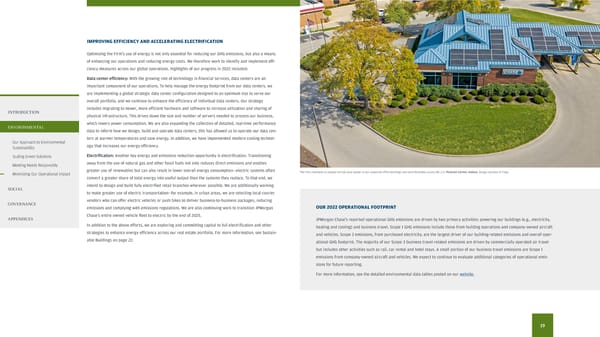IMPROVING EFFICIENCY AND ACCELERATING ELECTRIFICATION Optimizing the Firm’s use of energy is not only essential for reducing our GHG emissions, but also a means of enhancing our operations and reducing energy costs. We therefore work to identify and implement ef- ciency measures across our global operations. Highlights of our progress in 2022 included: Data center efciency: With the growing role of technology in fnancial services, data centers are an important component of our operations. To help manage the energy footprint from our data centers, we are implementing a global strategic data center confguration designed to an optimum size to serve our overall portfolio, and we continue to enhance the efciency of individual data centers. Our strategy includes migrating to newer, more efcient hardware and software to increase utilization and sharing of INTRODUCTION physical infrastructure. This drives down the size and number of servers needed to process our business, which lowers power consumption. We are also expanding the collection of detailed, real-time performance ENVIRONMENTAL data to inform how we design, build and operate data centers, this has allowed us to operate our data cen- ters at warmer temperatures and save energy. In addition, we have implemented modern cooling technol- Our Approach to Environmental ogy that increases our energy efciency. Sustainability Scaling Green Solutions Electrifcation: Another key energy and emissions reduction opportunity is electrifcation. Transitioning Meeting Needs Responsibly away from the use of natural gas and other fossil fuels not only reduces direct emissions and enables Minimizing Our Operational Impact greater use of renewables but can also result in lower overall energy consumption—electric systems often The Firm continues to expand on-site solar power at our corporate ofce buildings and retail branches across the U.S. Pictured: Carmel, Indiana. Image courtesy of EVgo. convert a greater share of total energy into useful output than the systems they replace. To that end, we SOCIAL intend to design and build fully electrifed retail branches wherever possible. We are additionally working to make greater use of electric transportation—for example, in urban areas, we are selecting local courier GOVERNANCE vendors who can ofer electric vehicles or push bikes to deliver business-to-business packages, reducing emissions and complying with emissions regulations. We are also continuing work to transition JPMorgan OUR 2022 OPERATIONAL FOOTPRINT APPENDICES Chase’s entire owned vehicle feet to electric by the end of 2025. JPMorgan Chase’s reported operational GHG emissions are driven by two primary activities: powering our buildings (e.g., electricity, In addition to the above eforts, we are exploring and committing capital to full electrifcation and other heating and cooling) and business travel. Scope 1 GHG emissions include those from building operations and company-owned aircraft strategies to enhance energy efciency across our real estate portfolio. For more information, see Sustain- and vehicles. Scope 2 emissions, from purchased electricity, are the largest driver of our building-related emissions and overall oper- able Buildings on page 22. ational GHG footprint. The majority of our Scope 3 business travel-related emissions are driven by commercially operated air travel but includes other activities such as rail, car rental and hotel stays. A small portion of our business travel emissions are Scope 1 emissions from company-owned aircraft and vehicles. We expect to continue to evaluate additional categories of operational emis- sions for future reporting. For more information, see the detailed environmental data tables posted on our website. 19
 2022 Environmental Social Governance Report Page 20 Page 22
2022 Environmental Social Governance Report Page 20 Page 22